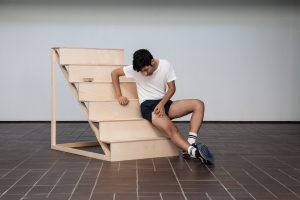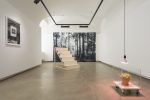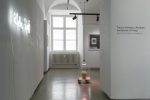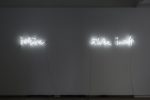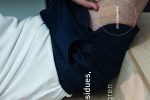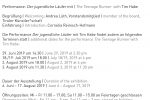Traces, Glimmers, Residues and Specks of Things
Conny Karlsson Lundgren
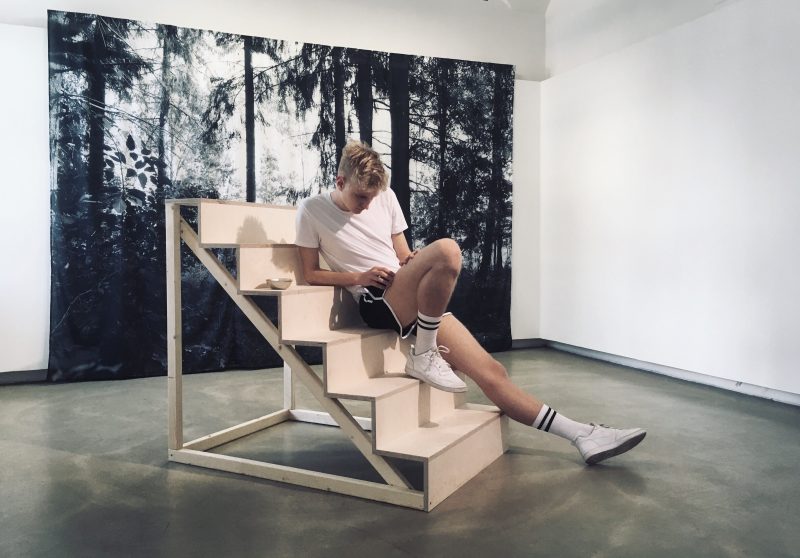
Conny Karlsson Lundgren, is fascinated by the ephemeral, seemingly temporary traces and moments that together form a larger context. His work is concerned with the transmission of radical, alternative queer and feminist realities. Starting point for the exhibition project was the encounter between the artist and an art collector. Through their dialog and tracing intimate memories the performance “The Teenage Runner”, unfolds how an artwork has been transposed into his art collection. The new German version, Der jugendliche Läufer, has been developed specially for the Neue Galerie and will be performed during the run of the exhibition.
The title of the exhibition comes from the Cuban/American queer theorist José Esteban Muñoz and his essay Ephemera as Evidence (1996), where he reflects on the temporary, the ephemeral as a crucial element in the alternative historical writing of marginalized communities, such as LGBTQI+ people or other minorities – communities that are not always documented or defined in official archives. The ephemeral becomes a kind of evidence of what has transpired but certainly not the thing itself. It can be seen as the in-between spaces, memories, glimmers, the remains, and new narratives emerge by following ”traces, glimmers, residues, and specks of things.” In his artistic practice Karlsson Lundgren works with film, text, image and document on an associative history writing that explores boundaries between social, political and private identity.
However, the artist formulates a less political but more personal and intimate exhibition for the Neue Galerie that combines newer works with older ones and put them into a larger context. What the collected works share is that they retrace intimate memory images, identity processes, senses and sensations, while navigating bodily experiences through choreography. They touch on narratives such as adolescence, sensitive plants, early slow disco tunes and cruising Japanese temple gardens
His approach on hazy memories of intimacy, desire and yearning, both his own and borrowed experiences can be read as a kind of retrospective on adolescence but also on his own artistic Oeuvre. Like stage sets for the chapters in a theatre piece the fragmented memories, ephemeral, seemingly temporary traces and moments create a safe space. Together they form an evasive and searching transitional phase into adulthood, with all the identity processes that come with it.
The individual words “traces, glimmers, residues, and specks of things” can also be seen as entries and alternative titles for the four works shown in the exhibition.
I Need Somebody To Love Tonight / Jag behöver någon att älska inatt
A small neon sign pulsates at 105 BPM (beats per minute), the same rhythm as a slow disco song with the same English title as the piece. Sylvester, once described as “the embodiment of disco”, who challenged the gender binary and later became an activist during the onset of the AIDS epidemic, released the original song in 1979. Patrick Cowley, a pioneer of electronic dance music and an early casualty of the above-mentioned plague, wrote the song itself. The instrumental version was also featured in one of the many soundtracks he produced for gay porn films during this period. The letters of the neon sign are based on Karlsson Lundgren’s own handwriting. Three words in the song title, translated into Swedish, have been traced from notebooks and diaries written during his adolescence years. The initiated gesture illuminates the fragmentation of memory over time and touches a brief moment of queer history through the remains of a dismantled song, which adds an intimate and private coming-of-age narrative consisting of urgent longings and desires.
The Teenage Runner
After a lecture by Karlsson Lundgren at an art institution in northern Sweden, someone in the audience initiated contact. The person, a collector, seemed to have a carefully selected collection of mainly American photo-based art with a queer approach – somewhat a surprising finding in this rural area. They initiated a dialogue and started a process of going through the art collection.
The Teenage Runner unfolds a specific fragment of a collection and draws parallels between different narratives that combine hazy memories, erotic sensations, scientific texts and poetry with philosophy. All of them lead back to a photograph by Arthur Tress, Teenage Runners (Band-Aid Fantasy) from 1976. The combination of voices from the collector, the photographer, the artist, the performers and others, becomes a way of reconstructing and re-visiting the memory of a single event and examines how an artwork has been transposed into a collection. Collecting can be an intimate act of lust and desire, an identity process, a method of addressing a need to belong, but primarily a means of creating a room of one’s own.
The Teenage Runner consists of five parts: The Collector, The Glade, The Stairs and Sensitiva. Together they form the stage set for a performance – The Teenage Runner, which will be performed during the opening and five more times during the exhbition period. The new German version of the performance, Der jugendliche Läufer with Vienna-based actor Tim Habe, has been developed specially for the exhibition at the Neue Galerie.
Additonaley the documention of the performance The Teenage Runner with actor Ali Qasemi, which was performed 2018 in the frame of Conny Karlsson Lundgren´s solo exhibiton at Sandviken Kunsthal, is shown in the exhibition.
The Teenage Runner, special thanks to Åke Lindberg, Lars Rune Larsson, Arthur Tress, Ali Qasemi, Johan Ågren and Daniel Palmgren. English translation by Conny Karlsson Lundgren and Benny Nemerofsky Ramsay. Produced with the support from Sandviken Konsthall and Neue Galerie Innsbruck
Gesture
The gesture, a subtle body movement, can be understood as a carrier of identity. In the text Gesture, Ephemera and Queer Feeling José Esteban Muñoz uses the term as a tool to expose social conventions and their demands on how different bodies should be and behave. Muñoz explores his physical memories, where the body reveals itself through an unconscious violation of established codes, and illuminates how queer bodies and non-normative movements are exposed and judged by society. The film Gesture is a collaboration between Karlsson Lundgren and the choreographer and dancer Dinis Machado (SE/PT), in which they trace private experiences, sensations and body memories. Short sentences were developed into a score inspired by Muñoz’s text, which is interpreted and embodied in a series of movement phases: Walk straight. To feel the carpet texture on my face and arm. To come. Open your mouth with desire and discomfort. To be put against the wall and like it. Female leg crossing standing. Be on points. To point. To be pointed at. Fight like a queen. To be touched by the air while dancing, etc.
Gesture: director: Conny Karlsson Lundgren, performer: Dinis Machado, Cinematography: Maja Dennhag, 1st assistant camera: Majaq Julén, sound recordist: Felix Aneer, Sound editing: Jesper Norda. Produced with support from Haninge Konsthall.
Residues (Kanazawa)
Residues (Kanazawa) revisit fragments of an early performance conducted during Karlsson Lundgren’s studies in Kanazawa. The historical settings of the Japanese University City, with its many gardens and ancient shrines, became a stage set for a series of interventions (or residues) in public spaces by the artist. At the turn of the millenium, sexual and gender minorities, and even premarital erotic encounters were still widely questioned in Japan, and young couples often lived with their parents until marriage. Parks offered a clandestine venue, a temporary pleasure garden for nocturnal lovers to act on their desires while providing a “safe” space for marginalized communities. The act of cruising, with it’s coded behavior, has been an essential part of queer culture, but has rapidly transitioned into different forms with the emergence of dating apps. The gesture and the accompanying diary entries in the performative work accentuate an alternative sanctuary for desires that has organically evolved – and in the times of digital intimacy cultures seizes to exist.
exhibition brochure for download
